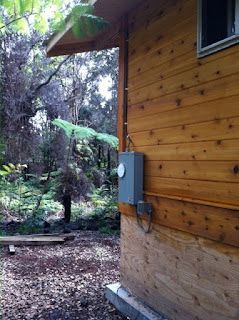After some investigation, we decided to go with a concrete tank from Pacific Gunite. They had the most experience on the island with these types of tanks. The cost was twice what a steel tank would have been, but we decided the quality, durability and look were worth the investment. We could bury most of the tank below grade, and with a concrete lid, it would be sturdy enough to build a shop or storage shed on top.
The tank installation was very interesting! I had never seen something like this built before. The hole for the tank had already been excavated last fall when we had the other sitework done. The tank crew placed a layer of fine base gravel, then formed and poured the bottom of the tank. Next, they put up three layers of different sized wire mesh, from coarse on the inside, to fine on the outside. Then they sprayed the gunite (concrete) onto the wire mesh, on the inside and on the outside. The tank wall is about 4 inches thick at the bottom and about 2 inches thick at the top. Finally, they formed and poured the lid. They also formed and poured an interior support column at the same time. This whole process took about six days over a two-week period.
 |
| Installing the wire mesh |
 |
| Wire mesh reinforcing completed |
 |
| Spraying gunite on the inside |
 |
| Spraying gunite on the outside and troweling the inside |
 |
| Smoothing the outside |
 |
| Forming the bottom of the lid |
 |
| Additional formwork for the lid (under a rain tarp) |
 |
| Lid reinforcement |
 |
| One of four downspouts connected to the roof gutters |

























